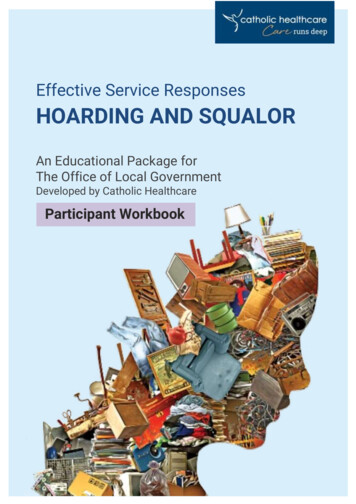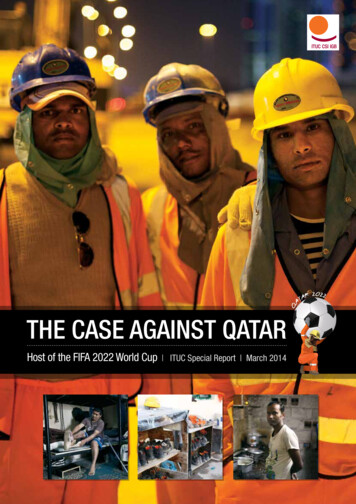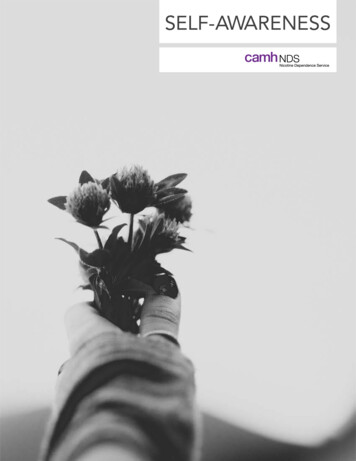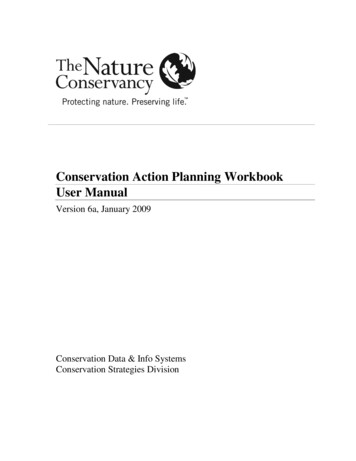
Transcription
Effective Service ResponsesHOARDING AND SQUALORAn Educational Package forThe Office of Local GovernmentDeveloped by Catholic HealthcareParticipant Workbook
What is Hoarding and Squalor?What do the words mean?Hoarding Is derived from hord, a Middle English word which, in turn, has links to the Gothicword huzd meaning treasure. The word hoarding also is used to describe a fence put up around a building whenit is being erected or repaired. In the context of this training package, hoarding means acquiring and havingtrouble discarding a large volume of possessions which others would consideruseless or of limited value.Squalor Is derived from squalidus, a Latin word meaning rough, coated with dirt, filthy. In relation to a place, squalor is used to describe somewhere that is cluttered, filthyor unclean through neglect.Common characteristics of hoarding and squalor situationsThe first thing to remember is that each person who hoards and is living in squalor is anindividual with a unique set of life experiences, beliefs and values. Generally, aperson who hoards and is living in squalor: cannot stop themselves bringing items into the home believes that the items are in some way part of themselves is unable to effectively categorise items is affected by indecision is unable to discard items without feeling distressed has lost control of their living environment feels shame about their situation may or may not seek help depending on their level of insight and feelings ofshame.1Hoarding and Squalor: Effective Service Responses, Participant Workbook,2021 Catholic Healthcare
How common is hoarding? International Research in Europe and North America suggests that 600,000 to 1.2million Australians may have an issue with hoarding (Morgan, 2010). Up to 2% to 5% of population may exhibit compulsive hoarding behaviours(Mataix-Cols et al 2010:559). Hoarding is a contributing factor in 24% of fire fatalities over 50 in Melbourne(Aufiero, Carlone, Hawkins, Murdy, 2011)/ Can begin– in childhood with mild symptoms in mid-teens, moderate symptoms in 20s– in adulthood after a stressful or traumatic eventWhy Do People Hoard or Live in Squalor?There is no easy answer to this question. There is a wide variety of causes andcombinations of causes of hoarding and squalor. Health, medical and communityservice practitioners will cite different reasons to people who hoard.Reasons given by health, medical and community servicesprofessionals Family influences and experiences In response to significant life events (e.g. war, trauma, extreme poverty) Difficulty with executive functioning (e.g. processing information, categorisation,decision making, memory) Emotionally driven reinforcement patterns Inability to form meaningful personal relationships Cognitive impairment caused by dementia, alcohol related brain damage Mental health issues (e.g. Hoarding Disorder, schizophrenia, depression)Reasons given by people who hoard Protects them from emotional and other harm by prevents other people gettingtoo close Possessions create a feeling of security Strong emotional attachments to items A belief that the items are worth valuing and/or might be useful in the future A strong desire not to be wasteful An intention to sort through accumulated belongings The situation is reflective of negative feelings about self (e.g. feeling like rubbish,not valued, broken).2Hoarding and Squalor: Effective Service Responses, Participant Workbook,2021 Catholic Healthcare
What about Animal Hoarders?Animal hoarders are people who accumulate a large number of animals, usually catsor dogs. They tend to be older women: 76% female, 46% over 60 years (Patronek,1999). Animal hoarding is an extremely difficult behaviour to change. After animalsare removed or the situation is brought under control, the recidivism rate is around100%. (Ockenden, De Groef, Marston, 2014)Sub-groups of animal hoarders include: Incipient hoarders in early stages of hoarding Overwhelmed caregivers who are strongly attached to animals, aware of theproblem but cannot provide adequate care Rescuers who may oppose euthanasia, have tried initially to place animals butwho only trust themselves to provide care Breeder hoarders who may initially selectively breed for shows or sale, continue tobreed when conditions deteriorate and see themselves as animal care experts Exploiters who may claim to be breeders but lack empathy for people or animals(e.g. puppy farms).Common key characteristicsAnimal hoarders commonly: are unable to provide minimum standards of space, nutrition, sanitation orveterinary care cannot see the detrimental effect on the animals, other people or theenvironment continue obsessively to maintain or accumulate animals despite a usuallydeteriorating environment deny or downplay that there is a problem.3Hoarding and Squalor: Effective Service Responses, Participant Workbook,2021 Catholic Healthcare
Hoarding, Squalor and Mental HealthHistorical perspectives Diogenes Disorder, senile squalor syndrome, was recognised in 1966 Until recently, people who hoard and live in squalor have been grouped uneasilywith obsessive-compulsive disorder (OCD) DSM-5, which was released in May 2013, first classified Hoarding Disorder as astand alone mental disorder.DSM-5 criteria for hoarding disorderAccording to the DSM-5, the following six criteria must be met for a diagnosis ofhoarding disorder:A. The person always finds it difficult to discard an acquired item, regardless of itsactual value.B. This difficulty is based on two things: a perceived need to save the item anddistress at the thought of discarding it.C. The person’s possessions accumulate and fill up living and working areas in thehouse (e.g. bedrooms, kitchens) so that they can’t be used for the purposes theywere designed. If living areas are uncluttered, it is due to the actions of othersD. These factors cause significant disruptions to socialisation and function.E. These symptoms cannot be attributed to another medical condition.F.These symptoms cannot be solely attributed to another mental disorder like OCDor schizophrenia.4Hoarding and Squalor: Effective Service Responses, Participant Workbook,2021 Catholic Healthcare
Hoarding and Problems with CategorisationUsual Method ofOrganisationHoarding Method ofOrganisationDecision to keep objectDecision to keep objectObject is categorised into oneof several major categoriesObject is categorised into eitherone major category for all itemsor multiple categoriesObject is placed with othersimilar objects (e.g. crockery) insuitable location (e.g. kitchen)Object is placed in sight due tofears or in an existing pile in aliving area to be decided later5Hoarding and Squalor: Effective Service Responses, Participant Workbook,2021 Catholic Healthcare
Hoarding, squalor and NSW lawThe following Tasmanian legislation can be relevant to situations involving hoardingand squalor.Mental Health Act 2007 Section 14 of this act includes provision for the involuntary treatmentand admission of people to a mental health facility if the person issuffering from a mental illness and, because of that illness, isdetermined to require care, treatment or control to prevent them oranother person coming to serious harm.Section 23 of the act gives Magistrates the power to authorise amedical practitioner to visit, examine or observe a person todetermine if a mental health certificate should be issued. This sectionincludes provision for entering premises by force to assist themedical assessment.Guardianship Act, 1987 A Guardian is a person who is appointed under the Guardianship Actto make decisions for someone who does not have capacity to makedecisions. This can apply to people who: Do not have anyone to help them make decisions Has a disability and is at risk of abuse, neglect or exploitationIn NSW, the need for appointment of a guardian is determined by theGuardianship Tribunal. The Tribunal considers written evidenceprovided in the guardianship application as well as evidence frompeople attending the hearing, including the person in question. TheTribunal can appoint a private guardian or the NSW public guardianand authorise them to make certain types of decisionsResidential Tenancies Covers private, public and social housing tenantsTenants have the right to:Act, 2010 Have quiet enjoyment and use of the premises Have reasonable peace, comfort and privacy Have reasonable locks and security Have reasonable repairs and maintenance done Be given written notice if the landlord wants to end thetenancy agreement Refuse access to the landlord except in certaincircumstances and with proper notice Not be unlawfully evictedTenants have the responsibility to: Pay rent on time Care for the premises Pay for any damage caused by themselves or their guests Not alter, remove or add a lock or security device without thelandlord’s consent Not cause permit a public nuisance Not interfere with the peace comfort or privacy of neighbours Leave the premises in a similar condition to that when theyrented.Prevention to Cruelty of This act includes the following list of offences: Committing act of cruelty to animals including exercisingAnimals Act, 1979reasonable care to prevent cruelty; alleviate pain; and provideaccess to veterinary treatment if needed Failure to provide food drink or shelter6Hoarding and Squalor: Effective Service Responses, Participant Workbook,2021 Catholic Healthcare
Failure to provide animals with adequate exercise includingprovision for enough space to exercise for caged animalsTethering animals for unreasonable periods of time.Public Health Act, 2010 This act contains the following provisions relevant to situationsinvolving hoarding and squalor: Power to enter premises to seize, disinfect or destroy noxiousarticles (i.e., articles and animals infested with vermin)Drug and AlcoholTreatment Act 2007The objectives of this act are to: Provide for involuntary treatment of people with severesubstance dependence to protect their health and safety Facilitate comprehensive assessment and stabilisationthrough medical treatment Provide an opportunity to engage in voluntary treatment andrestore capacity to make decisions about substance use andpersonal welfare.An accredited medical practitioner must first issue a dependencycertificate. A magistrate then reviews its issuing. The person can bedetained for 28 days after the issuing of the certificate.Children and YoungPersons (Care andProtection) Act, 1998Reporting to Department of Communities and Justice with suspicionon reasonable grounds that a child is at risk of significant harmCommon Law andNuisance (doesn’tcome under statutes orlegislations)Common law is a set of laws and principles that have been developedover time through the courts. Common law can be used to protectthe rights of private landowners in relation to their properties. Thiscovers: Private nuisance when a person substantially andunreasonably interferes with another person’s right to useand enjoy their land. This can include interference by noise,sewerage or odour. Public nuisance when a person endangers the life, health,property morals or comfort of the public or substantially orunreasonably interferes with the public’s rights.Examples of nuisances interfering with the comfort, convenience, orhealth of an occupant are foul odours, noxious gases, smoke, dust,loud noises, excessive light, or high temperatures.7Hoarding and Squalor: Effective Service Responses, Participant Workbook,2021 Catholic Healthcare
An important consideration – How hoarding and squalor situationsare uncoveredPeople who hoard and live in squalor are less likely to seek intervention than to haveintervention imposed upon them. The most likely scenarios for identification occur: After the person has been hospitalised by emergency services, nursing staff orsocial workers After hospital discharge by community care services After a fire hazard notification has been made by neighbours or the Council After a fire incident and attendance by the Fire Brigade When there is risk of eviction by the landlord or housing provider.Animal hoarding situations came to attention when: There are complaints from neighbours about the noise made by the animals There is a strong smell of faeces or ammonia Stains, faeces or animal hair at entry doors and windowsills are noticed Stained curtains are noticed The person is very suspicious of visitors and reluctant to permit entry.EngagementKey Engagement IssuesThe following factors will influence the engagement process. The person: may not have chosen for, and may be resistant to, others getting involved may not see it as a problem or have insight into the situation may be ashamed about their behaviour and living environment may be living in unsanitary conditions with severe health and safety issues thatneed to be addressed immediately.The 1st Step: Developing TrustTrust is the most essential ingredient to successful engagement with a person whohoards or lives in squalor. So:8Hoarding and Squalor: Effective Service Responses, Participant Workbook,2021 Catholic Healthcare
Remember that trust is based on acceptance Get as much background information as possible before the initial approach Accept the person for where they are ‘at’ Give the person a sense that they are okay Understand the fears they may have about change Offer to help in resolving another area of life that may be related or unrelated totheir hoarding Establish trust before targeting the hoarding behaviour.Engagement Strategies First and foremost, accept the person for where they are now and listen, listen,listen. Do not show or verbalise judgments you might make. Control your reactions to sights and smells. Be prepared to make multiple visits and talk through the front door or windowsbefore being invited in. Keep turning up at regular, scheduled times until that occurs. Offer help and then follow through in getting landlords, Council, Police off theirimmediate backs and getting room to breathe.An Overview of Hoarding and Squalor Assessment ToolsSelf-assessment Tool Clutter Image RatingTool EnvironmentalCleanliness and ClutterScale A self-administered tool in Buried inTreasures BookHoarding Severity Scale gives a Clutter anda Difficulty Discarding scoreActivities of Daily Living (ADL) Scale givesan ADL, a living conditions and a safetyissues scoreSelf-administered tool that can be done byassessorA series of 9 photographs showingescalating clutter in a bedroom, kitchen,living roomAsks to pick the picture closest to beingaccurateRecords demographic details0-3 point rating on accessibility,accumulation, rooms, cleanliness, odour,vermin, effect on activities, need forrepairs, WHS9Hoarding and Squalor: Effective Service Responses, Participant Workbook,2021 Catholic Healthcare
Clutter Image Rating Scale – page 110Hoarding and Squalor: Effective Service Responses, Participant Workbook,2021 Catholic Healthcare
Clutter Image Rating Scale – page 211Hoarding and Squalor: Effective Service Responses, Participant Workbook,2021 Catholic Healthcare
Clutter Image Rating Scale – page 312Hoarding and Squalor: Effective Service Responses, Participant Workbook,2021 Catholic Healthcare
Clutter Image Rating Scale – page 413Hoarding and Squalor: Effective Service Responses, Participant Workbook,2021 Catholic Healthcare
Environmental Cleanliness and Clutter Scale – page 1Environmental Cleanliness and Clutter Scale – page 214Hoarding and Squalor: Effective Service Responses, Participant Workbook,2021 Catholic Healthcare
Environmental Cleanliness and Clutter Scale – page 315Hoarding and Squalor: Effective Service Responses, Participant Workbook,2021 Catholic Healthcare
16Hoarding and Squalor: Effective Service Responses, Participant Workbook,2021 Catholic Healthcare
Environmental Cleanliness and Clutter Scale – page 417Hoarding and Squalor: Effective Service Responses, Participant Workbook,2021 Catholic Healthcare
What are the potential roles for other service/support providers ina support plan addressing hoarding and squalor issues?Support/Service ProviderCase Management Service Potential RolesComprehensive assessmentConsultation/liaison with stakeholdersAdvocacy and referralSupport planning and implementationAged Care AssessmentTeams/RAS Comprehensive assessment of care and supportneeds of people over 50 (45 for indigenouspeople) Assessment of eligibility for Home andCommunity and residential aged care Assessment of the home environment by an OT Referral to support servicesPsychologists, Psychiatrists DiagnosisAssessment of capacityCounsellingTherapyCHSP, Home Care Packages,NDIS Domestic assistanceCommunity transportSocial support (individual and groups)Food services ie Meals on WheelsShoppingPersonal careHome modification & maintenanceAllied Health – Physio, OT, Podiatry, NutritionistetcPublic/Social Housing Providers Supporting people to maintain their tenancies Negotiating with tenant about health, safety andaccess issues Arranging property repairs Taking action to gain access to premisesMental Health Teams Assessment and support of people with mentalhealth issuesRSPCA Financial Advisory Services Financial counselling Assistance with budgeting Re-negotiation of payment arrangements andschedulesEmergency services Establishment of emergency response protocols Fire safety inspectionsMaking applications to access the propertyAssessment of living conditions of animalsSeizing and removal of poorly cared for animalsReferrals to animal welfare groups18Hoarding and Squalor: Effective Service Responses, Participant Workbook,2021 Catholic Healthcare
Accompanying support workers identified at riskof harm (Police)Support plan implementationDo: Be patient and allow all the time necessary Encourage, motivate and applaud progress and change Start with small steps and focus on one part of the home at a time Screen and select all direct support staff for their appropriateness before they gointo the home Develop formal service level agreements Adequately brief and debrief agency partners and support staff.Don’t Pass judgment Argue with the person Make decisions for the person Touch or remove the person’s belongings without asking permission Consider or treat the support plan as a clean-up service Go for the quick fix, the big clean-up Leave a skip at the property Expect that hoarding behaviours will miraculously stop or not re-appearWhat is capacity?Capacity describes an adult’s ability to make informed decisions for themselves. A person whohas capacity for decision making: understands the relevant facts understands the available options can evaluate the possible consequences of each option can see how these consequences could affect them can communicate their decision to others.Balancing duty of care with dignity of riskKey duty of care considerations in regard to situations involving hoarding and squalorinclude: the need to address threats to the person’s health and safety the person’s physical and cognitive functionality and their potential to improveaspects of their functionality19Hoarding and Squalor: Effective Service Responses, Participant Workbook,2021 Catholic Healthcare
the level and effect of the person’s insight into their hoarding and squalorbehaviour and situation.Key dignity of risk considerations in regard to situations involving hoarding andsqualor include the person’s rights to: choose from the available range of options freedom and independence take calculated risks.Key Messages There are different causes and combinations of reasons for hoarding and living insqualor The support response depends on treating each person as an individual and eachsituation as unique The overall aim of interventions is to enable the person and equip them withstrategies for exerting control over their hoarding behaviour and their livingenvironment The case management response rests on effective engagement with the personand the development of a trusting partnership It is important to take all the time necessary to engage, assess, plan, implementand monitor a support intervention A team approach by all people and agencies involved in the support plan isessential to progress.20Hoarding and Squalor: Effective Service Responses, Participant Workbook,2021 Catholic Healthcare
Your notes21Hoarding and Squalor: Effective Service Responses, Participant Workbook,2021 Catholic Healthcare
with obsessive-compulsive disorder (OCD) DSM-5, which was released in May 2013, first classified Hoarding Disorder as a stand alone mental disorder. DSM-5 criteria for hoarding disorder According to the DSM-5, the following six criteria must be met for a diagnosis of hoarding disorder: A.










